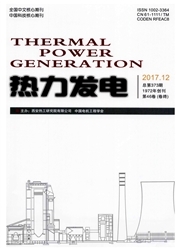

 中文摘要:
中文摘要:
针对燃煤电厂采用选择性催化还原(SCR)技术及低低温电除尘技术实现污染物超低排放,使得低温省煤器后烟气温度过低,引起引风机叶片表面硫酸盐沉积,严重影响引风机出力和锅炉带负荷等问题,本文以某污染物超低排放燃煤电厂引风机叶片表面厚达10mm的结垢样品为研究对象,详细分析了结垢灰样的元素、矿物构成与微观形貌.结果表明:引风机叶片表面灰样主要由硫酸钙、二水合硫酸钙、铵明矾(十二水硫酸铝铵)、硫酸铵和二氧化硅等结晶矿物质组成;灰样中氮、氢和硫元素质量分数高达22%,样品灼烧质量损失可达到60%以上;含硅铝元素球形颗粒完全被絮状硫酸盐裹覆;SCR脱硝系统出口氨逃逸量较高与低温省煤器后烟温过低是造成引风机叶片表面硫酸盐沉积的主要原因.建议应根据不同燃用煤种,结合氨逃逸水平、烟气含湿量、灰浓度等因素,进行低温省煤器出口温度设计.
 英文摘要:
英文摘要:
Currently,most power plants apply the selective catalytic reduction (SCR) technology and low temperature electrostatic precipitator to realize ultra-low emission. However,it will result in a much lower flue gas temperature behind the low temperature economizer and sulfates deposition on the induced draft fan blade, which seriously affects the working output of induced draft fan and boiler load. To solve this problem,ash deposits with thickness of 10 mm were collected from the induced draft fan blade in a coal- fired power plant with ultra-low emission. The physical and chemical properties of the ash deposits were analyzed by several techniques, such as the element analysis, the mineral matter composition analysis and microstructure analysis. The results show that, the ash samples consisted of calcium sulfate, calcium sulfate dehydrate,aluminium ammonium sulfate (twelve water ammonium aluminum sulfate), ammonium sulfate and silicon dioxide, the mass fraction of nitrogen, hydrogen and sulfur in ashes was about 22%,after burn- ing the loss mass of unprocessed ash samples was about 60%. The high ammonia concentration escaping from the SCR reactor and the low flue gas temperature behind the low temperature economizer were the main reason for deposition of sulfates on the induced draft fan. So it was suggested that the design of flue gas temperature at the low temperature economizer outlet need further study considering different kinds of coal,ammonia escape,flue gas humidity and ash content.
 同期刊论文项目
同期刊论文项目
 同项目期刊论文
同项目期刊论文
 期刊信息
期刊信息
